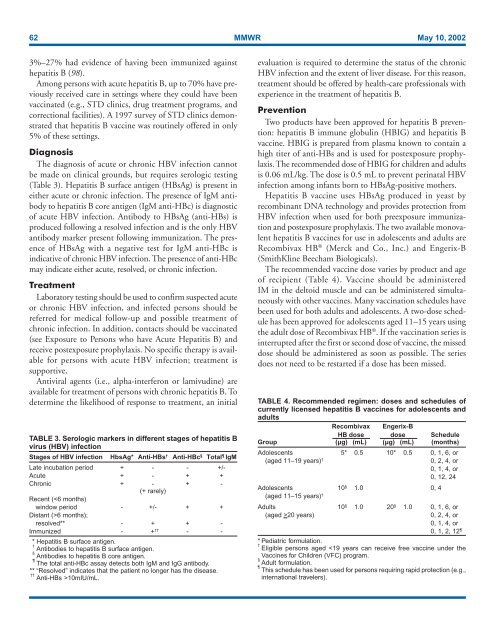You also want an ePaper? Increase the reach of your titles
YUMPU automatically turns print PDFs into web optimized ePapers that Google loves.
62 MMWR May 10, 2002<br />
3%–27% had evidence of having been immunized against<br />
hepatitis B (98).<br />
Among persons with acute hepatitis B, up to 70% have previously<br />
received care in settings where they could have been<br />
vaccinated (e.g., STD clinics, drug treatment programs, and<br />
correctional facilities). A 1997 survey of STD clinics demonstrated<br />
that hepatitis B vaccine was routinely offered in o<strong>nl</strong>y<br />
5% of these settings.<br />
Diagnosis<br />
The diagnosis of acute or chronic HBV infection cannot<br />
be made on clinical grounds, but requires serologic testing<br />
(Table 3). Hepatitis B surface antigen (HBsAg) is present in<br />
either acute or chronic infection. The presence of IgM antibody<br />
to hepatitis B core antigen (IgM anti-HBc) is diagnostic<br />
of acute HBV infection. Antibody to HBsAg (anti-HBs) is<br />
produced following a resolved infection and is the o<strong>nl</strong>y HBV<br />
antibody marker present following immunization. The presence<br />
of HBsAg with a negative test for IgM anti-HBc is<br />
indicative of chronic HBV infection. The presence of anti-HBc<br />
may indicate either acute, resolved, or chronic infection.<br />
Treatment<br />
Laboratory testing should be used to confirm suspected acute<br />
or chronic HBV infection, and infected persons should be<br />
referred for medical follow-up and possible treatment of<br />
chronic infection. In addition, contacts should be vaccinated<br />
(see Exposure to Persons who have Acute Hepatitis B) and<br />
receive postexposure prophylaxis. No specific therapy is available<br />
for persons with acute HBV infection; treatment is<br />
supportive.<br />
Antiviral agents (i.e., alpha-interferon or lamivudine) are<br />
available for treatment of persons with chronic hepatitis B. To<br />
determine the likelihood of response to treatment, an initial<br />
TABLE 3. Serologic markers in different stages of hepatitis B<br />
virus (HBV) infection<br />
Stages of HBV infection HbsAg* Anti-HBs † Anti-HBc § Total ¶ IgM<br />
Late incubation period + - - +/-<br />
Acute + - + +<br />
Chronic<br />
Recent (6 months);<br />
- +/- + +<br />
resolved** - + + -<br />
Immunized - + †† - -<br />
* Hepatitis B surface antigen.<br />
†<br />
Antibodies to hepatitis B surface antigen.<br />
§<br />
Antibodies to hepatitis B core antigen.<br />
¶<br />
The total anti-HBc assay detects both IgM and IgG antibody.<br />
** “Resolved” indicates that the patient no longer has the disease.<br />
††<br />
Anti-HBs >10mIU/mL.<br />
evaluation is required to determine the status of the chronic<br />
HBV infection and the extent of liver disease. For this reason,<br />
treatment should be offered by health-care professionals with<br />
experience in the treatment of hepatitis B.<br />
Prevention<br />
Two products have been approved for hepatitis B prevention:<br />
hepatitis B immune globulin (HBIG) and hepatitis B<br />
vaccine. HBIG is prepared from plasma known to contain a<br />
high titer of anti-HBs and is used for postexposure prophylaxis.<br />
The recommended dose of HBIG for children and adults<br />
is 0.06 mL/kg. The dose is 0.5 mL to prevent perinatal HBV<br />
infection among infants born to HBsAg-positive mothers.<br />
Hepatitis B vaccine uses HBsAg produced in yeast by<br />
recombinant DNA technology and provides protection from<br />
HBV infection when used for both preexposure immunization<br />
and postexposure prophylaxis. The two available monovalent<br />
hepatitis B vaccines for use in adolescents and adults are<br />
Recombivax HB ® (Merck and Co., Inc.) and Engerix-B<br />
(SmithKline Beecham Biologicals).<br />
The recommended vaccine dose varies by product and age<br />
of recipient (Table 4). Vaccine should be administered<br />
IM in the deltoid muscle and can be administered simultaneously<br />
with other vaccines. Many vaccination schedules have<br />
been used for both adults and adolescents. A two-dose schedule<br />
has been approved for adolescents aged 11–15 years using<br />
the adult dose of Recombivax HB ® . If the vaccination series is<br />
interrupted after the first or second dose of vaccine, the missed<br />
dose should be administered as soon as possible. The series<br />
does not need to be restarted if a dose has been missed.<br />
TABLE 4. Recommended regimen: doses and schedules of<br />
currently licensed hepatitis B vaccines for adolescents and<br />
adults<br />
Recombivax Engerix-B<br />
HB dose dose Schedule<br />
Group (µg) (mL) (µg) (mL) (months)<br />
Adolescents 5* 0.5 10* 0.5 0, 1, 6, or<br />
(aged 11–19 years) † 0, 2, 4, or<br />
0, 1, 4, or<br />
0, 12, 24<br />
Adolescents 10 § (aged 11–15 years)<br />
1.0 0, 4<br />
†<br />
Adults 10 § 1.0 20 § 1.0 0, 1, 6, or<br />
(aged >20 years) 0, 2, 4, or<br />
0, 1, 4, or<br />
0, 1, 2, 12 ¶<br />
* Pediatric formulation.<br />
†<br />
Eligible persons aged


